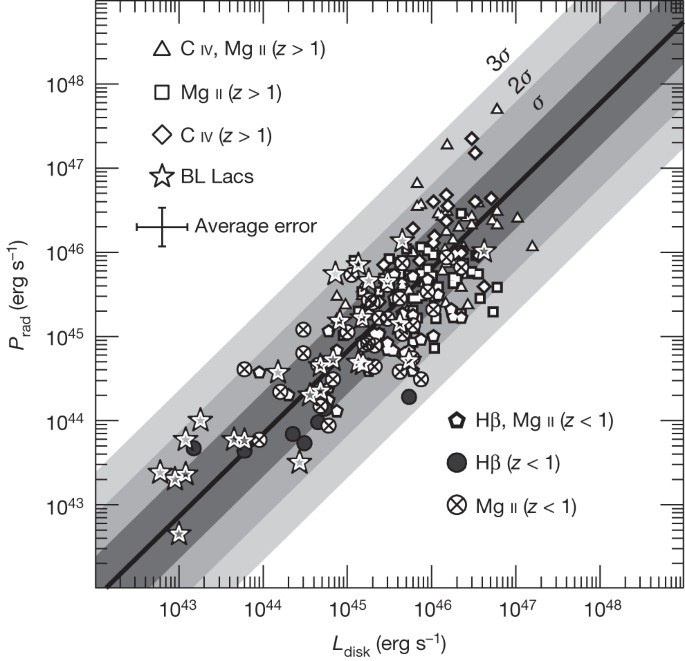
- Select a language for the TTS:
- UK English Female
- UK English Male
- US English Female
- US English Male
- Australian Female
- Australian Male
- Language selected: (auto detect) - EN
Play all audios:
ABSTRACT Theoretical models for the production of relativistic jets from active galactic nuclei predict that jet power arises from the spin and mass of the central supermassive black hole,
as well as from the magnetic field near the event horizon1. The physical mechanism underlying the contribution from the magnetic field is the torque exerted on the rotating black hole by the
field amplified by the accreting material. If the squared magnetic field is proportional to the accretion rate, then there will be a correlation between jet power and accretion luminosity.
There is evidence for such a correlation2,3,4,5,6,7,8, but inadequate knowledge of the accretion luminosity of the limited and inhomogeneous samples used prevented a firm conclusion. Here we
report an analysis of archival observations of a sample of blazars (quasars whose jets point towards Earth) that overcomes previous limitations. We find a clear correlation between jet
power, as measured through the γ-ray luminosity, and accretion luminosity, as measured by the broad emission lines, with the jet power dominating the disk luminosity, in agreement with
numerical simulations9. This implies that the magnetic field threading the black hole horizon reaches the maximum value sustainable by the accreting matter10. Access through your institution
Buy or subscribe This is a preview of subscription content, access via your institution ACCESS OPTIONS Access through your institution Subscribe to this journal Receive 51 print issues and
online access $199.00 per year only $3.90 per issue Learn more Buy this article * Purchase on SpringerLink * Instant access to full article PDF Buy now Prices may be subject to local taxes
which are calculated during checkout ADDITIONAL ACCESS OPTIONS: * Log in * Learn about institutional subscriptions * Read our FAQs * Contact customer support SIMILAR CONTENT BEING VIEWED BY
OTHERS POWERFUL EXTRAGALACTIC JETS DISSIPATE THEIR KINETIC ENERGY FAR FROM THE CENTRAL BLACK HOLE Article Open access 30 October 2020 A BLAZAR IN THE EPOCH OF REIONIZATION Article Open
access 17 December 2024 COUPLING BETWEEN THE ACCRETING CORONA AND THE RELATIVISTIC JET IN THE MICROQUASAR GRS 1915+105 Article 07 March 2022 REFERENCES * Blandford, R. D. & Znajek, R. L.
Electromagnetic extraction of energy from Kerr black holes. _Mon. Not. R. Astron. Soc._ 179, 433–456 (1977) ADS Google Scholar * Rawlings, S. & Saunders, R. Evidence for a common
central-engine mechanism in all extragalactic radio sources. _Nature_ 349, 138–140 (1991) ADS Google Scholar * Celotti, A. & Fabian, A. C. The Kinetic power and luminosity of
parsec-scale radio jets – an argument for heavy jets. _Mon. Not. R. Astron. Soc._ 264, 228–236 (1993) ADS CAS Google Scholar * Celotti, A., Padovani, P. & Ghisellini, G. Jets and
accretion processes in active galactic nuclei: further clues. _Mon. Not. R. Astron. Soc._ 286, 415–424 (1997) ADS Google Scholar * Maraschi, L. & Tavecchio, F. The jet–disk connection
and blazar unification. _Astrophys. J._ 593, 667–675 (2003) ADS Google Scholar * Punsly, B. & Tingay, S. J. PKS 1018–42: a powerful, kinetically dominated quasar. _Astrophys. J._ 640,
L21–L24 (2006) ADS CAS Google Scholar * Celotti, A. & Ghisellini, G. The power of blazar jets. _Mon. Not. R. Astron. Soc._ 385, 283–300 (2008) ADS CAS Google Scholar * Ghisellini,
G. et al. General physical properties of bright Fermi blazars. _Mon. Not. R. Astron. Soc._ 402, 497–518 (2010) ADS CAS Google Scholar * Tchekhovskoy, A., Narayan, R. & McKinney, J. C.
Efficient generation of jets from magnetically arrested accretion on a rapidly spinning black hole. _Mon. Not. R. Astron. Soc._ 418, L79–L83 (2011) ADS Google Scholar * Zamaninasab, M.,
Clausen–Brown, E., Savolainen, T. & Tchekhoskoy, A. Dynamically important magnetic fields near accreting supermassive black holes. _Nature_ 510, 126–128 (2014) ADS CAS PubMed Google
Scholar * Thorne, K. Disk–accretion onto a black hole. II. Evolution of the hole. _Astrophys. J._ 191, 507–519 (1974) ADS Google Scholar * Shaw, M. S., Romani, R. W. & Cotter, G. et
al. Spectroscopy of broad–line blazars from 1LAC. _Astrophys. J._ 748, 49 (2012) ADS Google Scholar * Shaw, M. S., Romani, R. W. & Cotter, G. et al. Spectroscopy of the largest ever
γ-ray-selected BL Lac sample. _Astrophys. J._ 764, 135 (2013) ADS Google Scholar * Francis, J. et al. A high signal–to–noise ratio composite quasar spectrum. _Astrophys. J._ 373, 465–470
(1991) ADS CAS Google Scholar * Vanden Berk, D. E., Richards, G. T. & Bauer, A. Composite quasar spectra from the Sloan Digital Sky Survey. _Astron. J._ 122, 549–564 (2001) ADS
Google Scholar * Calderone, G., Ghisellini, G., Colpi, M. & Dotti, M. Black hole mass estimate for a sample of radio-loud narrow-line Seyfert 1 galaxies. _Mon. Not. R. Astron. Soc._
431, 210–239 (2013) ADS Google Scholar * Ghisellini, G. & Tavecchio, F. Canonical high–power blazars. _Mon. Not. R. Astron. Soc._ 397, 985–1002 (2009) ADS CAS Google Scholar *
Ghisellini, G. & Tavecchio, F. Compton rockets and the minimum power of relativistic jets. _Mon. Not. R. Astron. Soc._ 409, L79–L83 (2010) ADS Google Scholar * Nolan, P. L., Abdo, A.
A. & Ackermann, M. et al. Fermi Large Area Telescope second source catalog. _Astrophys. J. Suppl. Ser._ 199, 31 (2012) ADS Google Scholar * Ghirlanda, G., Ghisellini, G., Tavecchio,
F., Foschini, L. & Bonnoli, G. The radio–_γ_-ray connection in Fermi blazars. _Mon. Not. R. Astron. Soc._ 413, 852–862 (2011) ADS Google Scholar * Nemmen, R. S. et al. A universal
scaling for the energetics of relativistic jets from black hole systems. _Science_ 338, 1445–1448 (2012) ADS CAS PubMed Google Scholar * Tchekhovskoy, A., Metzger, B. D., Giannios, D.
& Kelley, L. Z. Swift J1644+57 gone MAD: the case for dynamically important magnetic flux threading the black hole in a jetted tidal disruption event. _Mon. Not. R. Astron. Soc._ 437,
2744–2760 (2014) ADS Google Scholar * Peterson, B. M. & Wandel, A. Evidence for supermassive black holes in active galactic nuclei from emission-line reverberation. _Astrophys. J._
540, L13–L16 (2000) ADS CAS Google Scholar * McLure, R. J. & Dunlop, J. S. The cosmological evolution of quasar black hole masses. _Mon. Not. R. Astron. Soc._ 352, 1390–1404 (2004)
ADS CAS Google Scholar * Vestergaard, M. & Peterson, B. M. Determining central black hole masses in distant active galaxies and quasars. II. Improved optical and UV scaling
relationships. _Astrophys. J._ 641, 689–709 (2006) ADS CAS Google Scholar * Shakura, N. I. & Sunyaev, R. A. Black holes in binary systems. Observational appearance. _Astron.
Astrophys._ 24, 337–355 (1973) ADS Google Scholar * Livio, M., Ogilvie, G. I. & Pringle, J. E. Extracting energy from black holes: the relative importance of the Blandford-Znajek
mechanism. _Astrophys. J._ 512, 100–104 (1999) ADS Google Scholar * Meier, D. L. Grand unification of AGN and the accretion and spin paradigms. _New Astron. Rev._ 46, 247–255 (2002) ADS
Google Scholar * Tchekhovskoy, A., McKinney, J. C. & Narayan, R. General relativistic modeling of magnetized jets from accreting black holes. _J. Phys. Conf. Ser._ 372, 012040 (2012)
Google Scholar * Sikora, M., Stawarz, L. & Lasota, J.-P. Radio loudness of active galactic nuclei: observational facts and theoretical implications. _Astrophys. J._ 658, 815–828 (2007)
ADS CAS Google Scholar * Abdo, A. A. et al. The first catalog of active galactic nuclei detected by the Fermi Large Area Telescope. _Astrophys. J._ 715, 429–457 (2010) ADS CAS Google
Scholar * Ackermann, M. et al. The second catalog of active galactic nuclei detected by the Fermi Large Area Telescope. _Astrophys. J._ 743, 171 (2011) ADS Google Scholar * Shen, Y. et
al. A catalog of quasar properties from Sloan Digital Sky Survey data release 7. _Astrophys. J. Supp. Ser._ 194, 45 (2011) ADS Google Scholar * Ghisellini, G. Extragalactic relativistic
jets. _AIP Conf. Proc._ 1381, 180–198 (2011) ADS CAS Google Scholar * Sbarrato, T. et al. Blazar candidates beyond redshift 4 observed with GROND. _Mon. Not. R. Astron. Soc._ 433,
2182–2193 (2013) ADS Google Scholar * Fossati, G., Maraschi, L., Celotti, A., Comastri, A. & Ghisellini, G. A unifying view of the spectral energy distributions of blazars. _Mon. Not.
R. Astron. Soc._ 299, 433–448 (1998) ADS Google Scholar * Donato, D., Ghisellini, G., Tagliaferri, G. & Fossati, G. Hard X-ray properties of blazars. _Astron. Astrophys._ 375, 739–751
(2001) ADS Google Scholar * Bonnoli, G., Ghisellini, G., Foschini, L., Tavecchio, F. & Ghirlanda, G. The γ-ray brightest days of the blazar 3C 454.3. _Mon. Not. R. Astron. Soc._ 410,
368–380 (2011) ADS CAS Google Scholar * Ghisellini, G. & Tavecchio, F. Canonical high-power blazars. _Mon. Not. R. Astron. Soc._ 397, 985–1002 (2009) ADS CAS Google Scholar *
Nalewajko, K., Begelman, M. C. & Sikora, M. Constraining the location of gamma-ray flares in luminous blazars. _Astrophys. J._ 789, 161 (2014) ADS Google Scholar * Böttcher, M.,
Reimer, A., Sweeney, K. & Prakash, A. Leptonic and hadronic modeling of Fermi-detected blazars. _Astrophys. J._ 768, 54 (2013) ADS Google Scholar * Bentz, M. C., Peterson, B. M.,
Pogge, R. W., Vestergaard, M. & Onken, C. A. The radius–luminosity relationship for active galactic nuclei: the effect of host–galaxy starlight on luminosity measurements. _Astrophys.
J._ 644, 133–142 (2006) ADS Google Scholar * Koshida, S., Minezaki, T. & Yoshii, Y. et al. Reverberation measurements of the inner radius of the dust torus in 17 Seyfert galaxies.
_Astrophys. J._ 788, 159 (2014) ADS Google Scholar * Dermer, C. On the beaming statistics of γ-ray sources. _Astrophys. J._ 446, L63–L66 (1995) ADS Google Scholar * Sikora, M. &
Madejski, G. On pair content and variability of subparsec jets in quasars. _Astrophys. J._ 534, 109–113 (2000) ADS CAS Google Scholar * Tavecchio, F., Maraschi, L. & Ghisellini, G.
Constraints on the physical parameters of TeV blazars. _Astrophys. J._ 509, 608–619 (1998) ADS Google Scholar * Ghisellini, G. & Celotti, A. Relativistic large-scale jets and minimum
power requirements. _Mon. Not. R. Astron. Soc._ 327, 739–743 (2001) ADS CAS Google Scholar * Ghisellini, G. & Madau, P. On the origin of the γ-ray emission in blazars. _Mon. Not. R.
Astron. Soc._ 280, 67–76 (1996) ADS Google Scholar * Ghisellini, G. Electron-positron pairs in blazar jets and γ-ray loud radio galaxies. _Mon. Not. R. Astron. Soc._ 424, L26–L30 (2012)
ADS CAS Google Scholar Download references ACKNOWLEDGEMENTS F.T. and L.M. acknowledge partial funding through a PRIN–INAF 2011 grant. AUTHOR INFORMATION AUTHORS AND AFFILIATIONS *
Istituto Nazionale di Astrofisica – Osservatorio Astronomico di Brera, Via E. Bianchi 46, I–23807 Merate, Italy , G. Ghisellini, F. Tavecchio, L. Maraschi, A. Celotti & T. Sbarrato *
Istituto Nazionale di Astrofisica – Osservatorio Astronomico di Brera, Via E. Brera 28, I–20121 Milano, Italy , L. Maraschi * Scuola Internazionale Superiore di Studi Avanzati, Via Bonomea
265, I–34135 Trieste, Italy , A. Celotti * Istituto Nazionale di Fisica Nucleare – Sezione di Trieste, Via Valerio 2, I-34127 Trieste, Italy , A. Celotti * Dipartimento di Fisica e
Matematica, Università dell’Insubria, Via Valleggio 11, I–22100 Como, Italy, T. Sbarrato * European Southern Observatory, Karl-Schwarzschild-Strasse 2, 8578 Garching bei München, Germany ,
T. Sbarrato Authors * G. Ghisellini View author publications You can also search for this author inPubMed Google Scholar * F. Tavecchio View author publications You can also search for this
author inPubMed Google Scholar * L. Maraschi View author publications You can also search for this author inPubMed Google Scholar * A. Celotti View author publications You can also search
for this author inPubMed Google Scholar * T. Sbarrato View author publications You can also search for this author inPubMed Google Scholar CONTRIBUTIONS G.G. wrote the manuscript and fitted
all blazars presented. F.T., L.M., A.C. and T.S. contributed to the discussion of the implications of the results. CORRESPONDING AUTHOR Correspondence to G. Ghisellini. ETHICS DECLARATIONS
COMPETING INTERESTS The authors declare no competing financial interests. EXTENDED DATA FIGURES AND TABLES EXTENDED DATA FIGURE 1 JET POWER VERSUS RADIATIVE JET POWER. We compare the total
jet power and the radiative jet power for the blazars in our sample. The grey lines, as labelled, respectively correspond to equality and to _P_jet equal to 10-fold and 100-fold _P_rad. Same
symbols as in Fig. 1. The average error bar is indicated. EXTENDED DATA FIGURE 2 DISTRIBUTION OF RELEVANT QUANTITIES. A, Normalized redshift distribution for FSRQs (light hatching) and BL
Lacs (heavy hatching) in our sample. B, Normalized distribution of the ratio log(_L_disk/_L_Edd) for FSRQs in our sample. The black hole mass is the virial mass, calculated on the basis of
the width of the broad lines12, compared with a log-normal distribution having a width of _σ_ = 0.35 dex. C, Distribution of the bulk Lorentz factor. Hatching as in A. The plotted normal
distribution has a width of _σ_ = 1.4. D, Distribution of the ratio log(_P_jet/_L_disk) for our sources, including BL Lacs (hatching as in A). The shown log-normal distribution has a width
of _σ_ = 0.48 dex. EXTENDED DATA FIGURE 3 DISTRIBUTION OF JET POWERS. Jet power distribution for FSRQs (light hatching) and BL Lacs (heavy hatching) in our sample, compared with the disk
luminosity distribution as labelled: _P_p is the kinetic power of the (cold) protons, assuming one proton per emitting electron; _P_e is the power in relativistic emitting electrons; _P_B is
the jet Poynting flux; _P_rad is the power that the jet has spent in producing the observed radiation; _L_disk is the luminosity of the accretion disk. All distributions are fitted with a
log-normal distribution. The corresponding value of _σ_ (in dex) is reported. The average values of the distributions are 〈log(_L_disk)〉 = 45.5, 〈log(_P_rad)〉 = 45.3, 〈log(_P_B)〉 = 45.0,
〈log(_P_e)〉 = 44.4, 〈log(_P_p)〉 = 46.4 (units of luminosity and power are erg s−1). SUPPLEMENTARY INFORMATION SUPPLEMENTARY TABLE 1 This table contains relevant parameters of the blazars in
this study. Col. 1 and Col. 2: AR and Dec (J2000); Col. 3: redshift; Col. 4 – Col. 7: Logarithm of _P_rad, _P_e, _P_B, _P_p (powers in units of erg s1); Col. 8: bulk Lorentz factor; Col. 9:
viewing angle in degrees; Col. 10: Logarithm of the disk luminosity (in units of erg s1) as resulting from disk fitting; Col. 11: Logarithm of the disk luminosity (in units of erg s1) as
measured from the broad emission lines; Col. 12 – Col. 14: logarithm of the black hole mass (in units of the solar mass) estimated through the virial method12 using the H (Col. 12), MgII
(Col. 13) and CIV (Col. 14) broad emission lines. (XLSX 90 kb) POWERPOINT SLIDES POWERPOINT SLIDE FOR FIG. 1 POWERPOINT SLIDE FOR FIG. 2 RIGHTS AND PERMISSIONS Reprints and permissions ABOUT
THIS ARTICLE CITE THIS ARTICLE Ghisellini, G., Tavecchio, F., Maraschi, L. _et al._ The power of relativistic jets is larger than the luminosity of their accretion disks. _Nature_ 515,
376–378 (2014). https://doi.org/10.1038/nature13856 Download citation * Received: 25 April 2014 * Accepted: 11 September 2014 * Published: 19 November 2014 * Issue Date: 20 November 2014 *
DOI: https://doi.org/10.1038/nature13856 SHARE THIS ARTICLE Anyone you share the following link with will be able to read this content: Get shareable link Sorry, a shareable link is not
currently available for this article. Copy to clipboard Provided by the Springer Nature SharedIt content-sharing initiative



